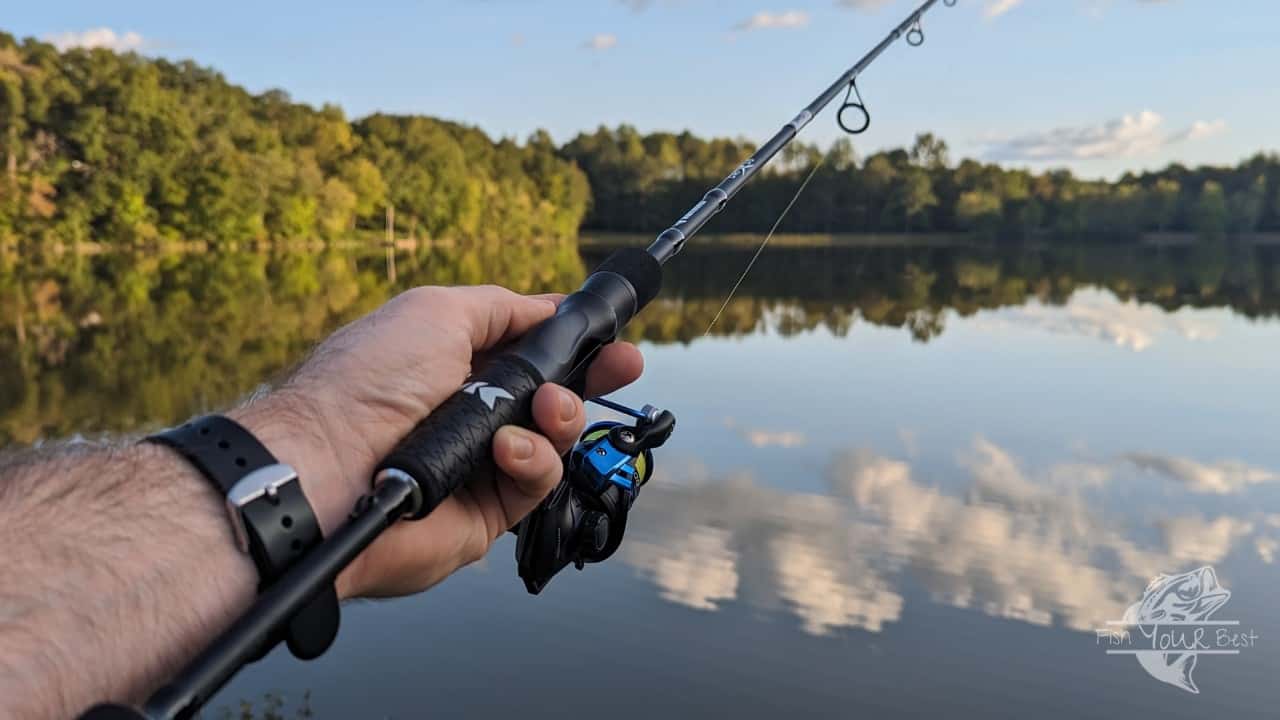The Ultimate Guide to Crappie Fishing Rods
Crappie fishing is a rewarding and exciting experience, but having the right rod can make the difference between a successful catch and a day of frustration. Whether you’re a seasoned angler or a beginner eager to learn, understanding the factors that make a quality crappie fishing rod is essential.
This comprehensive guide explores various types, lengths, actions, and powers to help you make informed decisions. We’ll uncover the elements behind choosing the right rod and how it can elevate your crappie fishing experience, providing insights into the impact of rod characteristics on casting accuracy, sensitivity, and hook-setting power.
Imagine the satisfaction of a well-planned crappie fishing trip where your rod becomes an extension of your angling intuition, responding with precision and reliability. By understanding the nuances of crappie fishing rods, you can optimize your approach, enhance your skills, and increase your catch rate, experiencing the joy of crappie fishing at its finest.
Whether refining your technique or exploring new waters, this guide is your companion to achieving crappie fishing excellence. Let’s get started!
Types of Crappie Fishing Rods
Understanding the many types of fishing rods for crappie fishing is a good baseline for any angler looking to increase their chances of success. Each rod type has unique attributes designed to enhance various aspects of crappie fishing, from bait presentation to bite detection.
Spinning Rods
A spinning rod is characterized by its fixed reel underneath the rod and guides facing down.
Key Features
- Versatility & Ease of Use: Ideal for casting lightweight lures and baits.
- Sensitivity: Paramount for detecting the subtle bites crappie are known for.
- Adaptability: Suitable for different fishing conditions and environments.
Fly Fishing Rods
A fly fishing rod is a specialized lightweight rod designed to cast an almost weightless artificial fly. It is characterized by its flexibility and length, allowing you to precisely present the fly with a controlled and rhythmic casting technique.
Key Features
- Unique Experience: Offers a hands-on and immersive way to fish.
- Sensitivity & Responsiveness: Unparalleled, allowing for immediate hook sets.
- Precision: Enables accurate placements in hard-to-reach spots.

Telescopic Rods
A telescopic fishing rod is designed to collapse to a compact size for convenient transport and storage without compromising rod length or functionality.
Key Features
- Convenience & Portability: Ideal for when you are on the move or have limited storage space.
- Versatility: Adapts quickly to different fishing conditions and environments.
- Adjustability: Can be adjusted to suit the situation, providing flexibility.
Ice Fishing Rods
An ice fishing rod is a short, sturdy rod that lets you precisely drop and control your bait through ice holes to target the fish below.
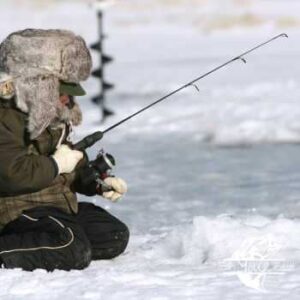
Key Features
- Specialized Design: Tailored to the demands of ice fishing environments.
- Construction: Materials and components function optimally in cold conditions.
- Precision Jigging: Maximizes your ability to entice crappie under the ice.
Trolling Rods
A trolling rod is a robust, long fishing rod designed to drag lures or bait behind a moving boat.
Key Features
- Strategic Choice: Covers vast expanses of water efficiently.
- Design: Tailored to withstand constant pressure and resistance.
- Passive Approach: Offer lures at different depths, adapting to the preferences of crappie.
Spider Rigging Rods
A spider rigging rod is a long fishing rod that you simultaneously deploy multiple rods in a fan-like arrangement around the front of the boat.
Key Features
- Effective Technique: Employ multiple rods to cover a wide swath of water.
- Length & Flexibility: Crucial for managing multiple lines effectively.
- Strategic Advantage: Allows you to explore different water columns and structures efficiently.
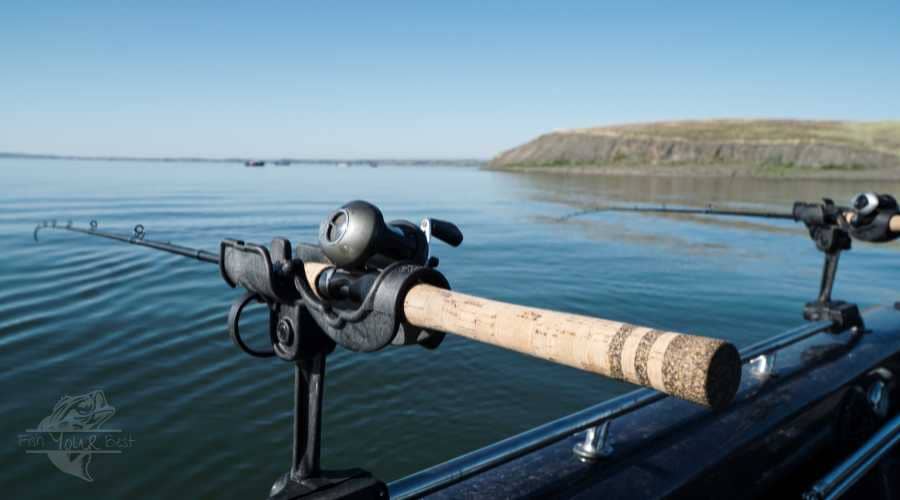
Knowledge of rod types is essential for navigating the challenges of varied fishing seasons and environments, ensuring you are well-equipped to maximize your chances of landing crappie under any circumstances. Understanding each rod type’s purpose allows you to refine your skills, explore various fishing techniques, and develop new strategies, offering a more rewarding angling experience.
Rod Length
Understanding the diversity in fishing rod lengths enables you to optimize your crappie fishing experience, with each length serving distinct purposes and offering unique advantages.
Shorter Rods: Ideal for confined spaces, providing better control and precise jigging actions.
Medium-Length Rods: Versatile, suitable for casting and jigging in open waters.
Longer Rods: Essential for techniques like spider rigging and trolling, enabling extensive water area coverage.
Related Article:
Why Are Crappie Rods So Long?
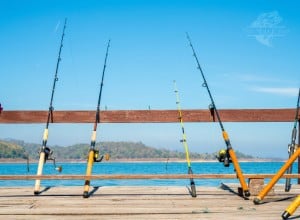
Precision Casting
Casting accuracy is influenced by fishing rod length, affecting control and precision.
Shorter Rods: Provide greater accuracy and enhanced control, ideal for structured environments.
Longer Rods: Excel in achieving greater casting distance but can compromise accuracy.
Reaching Out
Fishing rod length impacts overall casting distance.
Shorter Rods: More suited to situations where precision and control are required.
Longer Rods: Allow for longer casts, advantageous in large open waters.
Adapt and Conquer
Effectively and efficiently implement your desired fishing technique by pairing it with the appropriate fishing rod length.
Comparison Table: Rod Length and Fishing Techniques
| Rod Length | Suitable Techniques | Benefits |
| Short | Jigging, Drop Shotting | Enhanced control and sensitivity; Precision in lure placement |
| Medium | Casting, Retrieving | Versatility; Balanced accuracy, sensitivity, and distance |
| Long | Trolling, Spider Rigging | Extended reach; Ability to cover large water areas |
Stow and Go
The transportation and storage of crappie fishing rods become more complex as rod length increases. Longer rods may require special accommodations, such as roof racks or rod holders, to transport them safely.
Shorter Rods: More convenient to transport and store, practical for hassle-free mobility.
Longer Rods: Can be challenging, requiring more space and careful handling.
Boat Deck Dynamics
Rod length impacts how it is stored on a boat, with each length presenting its unique set of considerations.
Shorter Rods: More convenient and manageable to store.
Longer Rods: Requires strategic and secure storage solutions.
Understanding the relationship between rod length and various aspects of fishing helps you choose the best gear and tweak your strategy. Ultimately, the fish you’re after, the conditions you’re in, and what you prefer determine the optimal equipment length. To make your fishing trips more pleasant and hassle-free, consider rod length when picking out your next fishing rod.
Rod Action
Knowledge of rod actions is essential in refining techniques and enhancing catch rates. Rod action affects sensitivity, lure control, and hook setting power. Understanding the differences is key to a successful crappie fishing experience.
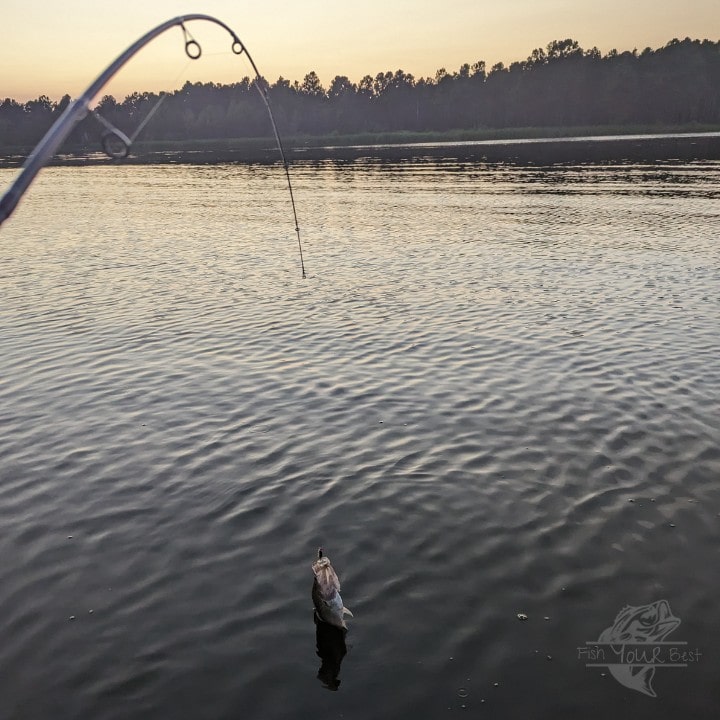
Feeling the Bite
The action of a fishing rod is important in determining its sensitivity, aiding you in detecting the subtle bites of crappie.
Comparison Table: Rod Action and Sensitivity
| Rod Action | Sensitivity Level | Suitable For |
| Fast | High | Detecting subtle bites, quick hook sets |
| Moderate | Medium | Versatile fishing techniques, balanced feel |
| Slow | Low | Cushioning sudden moves, using light lines and hooks |
Balancing Act
In crappie fishing, you will use a variety of lures such as jigs, spinners, and soft plastics, which can vary in weight and potentially impact your choice of fishing rod.
Fast Action Rods: Designed to handle lighter lures, allowing for precise presentations.
Moderate Action Rods: Can accommodate a broader range of lure weights, offering versatility.
Slow Action Rods: Well-suited for casting heavier lures, absorbing the shock effectively.
Setting the Hook
Proper hook setting is crucial due to crappie’s delicate and paper-thin mouths, which can easily tear if handled roughly. It’s important to use a gentle and swift hook set, avoiding excessive force to prevent causing damage to their mouth.
Comparison Table: Rod Action and Hook Setting Power
| Rod Action | Hook Setting Power | Suitable For |
| Fast | High | Quick and powerful hook sets |
| Moderate | Medium | Versatile fishing situations with balanced power |
| Slow | Low | Light lines and small hooks with delicate sets |
Battling the Catch
Rod action plays a part in determining a fishing rod’s fighting ability, impacting how well you can control and land a fish once hooked.
Fast Action Rods: Offer a high level of control and power.
Moderate Action Rods: Provide a versatile fighting ability suitable for a range of species and conditions.
Slow Action Rods: Excel in cushioning the fight, offering the most give and absorbing sudden movements effectively.
Tailoring Rod Action to Your Fishing Technique
Tailoring rod action to your fishing technique involves selecting a rod with the appropriate level of flexibility and responsiveness to complement the specific demands of your chosen fishing method.
Fast Action Rods: Ideal for techniques requiring high sensitivity and rapid hooksets.
Moderate Action Rods: Suited for a variety of techniques due to their balanced blend of sensitivity, power, and flexibility.
Slow Action Rods: Generally not used for crappie fishing but are advantageous in minimizing the risk of hook pull-out and line breakage.
Understanding the relationship between rod action and various aspects of fishing is essential for crappie anglers. Whether it’s sensitivity, lure weight, hook setting power, fighting ability, or fishing technique, each is influenced by the rod’s action. Selecting the right rod action based on fishing conditions, lure type, and personal preference can significantly impact your ability to present baits effectively and respond promptly to bites, leading to a more prosperous and enjoyable crappie fishing experience.
Rod Power
Similar to a fishing rod’s action, rod power affects your ability to cast lures accurately, set hooks effectively, and successfully battle fish. You must select the appropriate rod power and balance it with the right action to adapt to varying conditions and techniques.
Crappie Size Considerations
The size of the fish influences the required fishing rod power, as larger, stronger fish necessitate a rod with greater power to withstand the force and avoid breakage. Targeting crappie typically requires a rod with lighter power to ensure sensitivity and a proper presentation of the lure, allowing you to detect even the slightest bites.
Ultra-Light to Light Power Rods:
- Ideal for: All sizes of crappie.
- Benefits: High sensitivity, prevents damage to crappie’s mouth, suitable for lighter lines and smaller lures.
Medium Power Rods:
- Ideal for: Larger crappie in dense cover.
- Benefits: More backbone, versatile, suitable for heavier lines and lures.
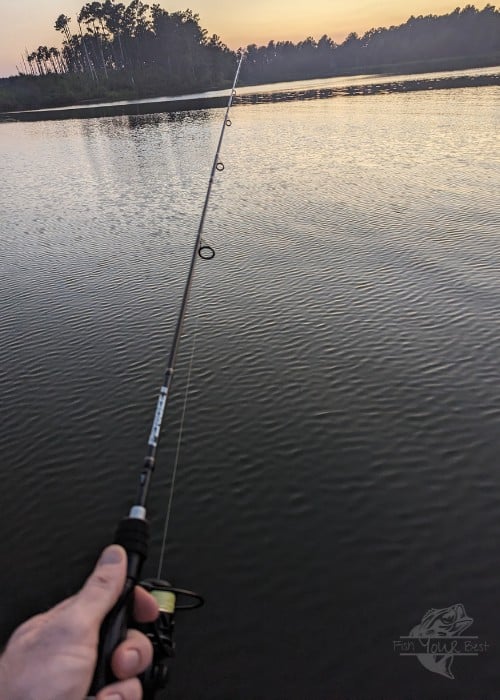
Dynamics of Lure Weight and Rod Power
When selecting the appropriate fishing rod power, it is crucial to consider the weight of your lure, as it directly influences the rod’s performance, responsiveness, and ability to cast to targeted locations accurately. A well-matched rod power and lure weight will optimize your control and sensitivity, allowing for precise presentations and effective hook sets, increasing your chances of success.
Comparison Table: Rod Power and Lure Weight
| Rod Power | Suitable Lure Weight | Benefits |
| Ultra-Light | Very Light | Delicate presentations; Natural lure action |
| Light | Light | Precision in lure placement; Finesse techniques |
| Medium | Moderate | Versatility; Balanced setup for varied lures |
| Heavy | Heavy | Strength for larger lures; Depth reach |
Balancing Line Strength and Rod Power
When selecting the appropriate fishing rod power, it is crucial to consider the line strength, as mismatched power and line strength can lead to either the line breaking or the rod snapping under the pressure of a catch. A well-matched rod power and line strength will ensure optimal performance, allowing you to efficiently battle and land crappie without compromising the integrity of your gear and losing your catch due to equipment failure.
Ultra-Light to Light Power Rods: Best paired with 2 to 8-pound test lines, ideal for delicate presentations.
Medium Power Rods: Can handle 6 to 12-pound test lines, providing versatility in various fishing scenarios.
Heavy Power Rods: Designed for 12 to 20-pound test lines, ideal where high tensile strength is required.
Sensitivity Considerations
The rod’s sensitivity is crucial when selecting the appropriate fishing rod power. It determines how well you can detect bites, nudges, or any interaction the crappie has with your lure, enabling more effective response times.
Ultra-Light to Light Power Rods: More sensitive, allowing for detection of the slightest nibbles.
Medium Power Rods: Offer a balanced level of sensitivity, suitable for various fishing situations.
Heavy Power Rods: Generally have lower sensitivity, ideal where strength is more critical than bite detection.
Hook Set Strength
When selecting the appropriate fishing rod power, it is necessary to consider the strength required for setting the hook, as this ensures that your fishing rod can handle the force applied without compromising the integrity of the rod or losing the fish. A well-matched hook set strength and rod power will enable you to securely and efficiently land your catch.
Ultra-Light to Light Power Rods: Allow for a softer hook set, reducing the risk of tearing the hook through the mouth of the crappie.
Medium Power Rods: Offering balanced hook setting power, suitable for a range of fishing situations.
Heavy Power Rods: Provide a solid hook set, essential when targeting larger and more powerful fish.
Understanding the relationship between rod power and various aspects of fishing is essential for crappie anglers. Whether it’s crappie size, lure weight, line strength, sensitivity, or hook set, the rod’s power influences each. Selecting the right rod power based on fishing conditions, targeted species, and personal preference can improve your ability to present baits effectively and respond promptly to bites, leading to a more successful and enjoyable crappie fishing experience.
Importance of Material and Construction
The material and construction of a fishing rod contribute to the rod’s sensitivity, weight, balance, and durability. These are key factors in detecting subtle bites and successfully landing crappie. A well-constructed rod tailored to your needs and preferences enhances your fishing experience by providing the right balance of sensitivity, strength, and finesse.
Graphite Rods
Graphite rods should be considered when determining the best material for fishing rod construction due to their high sensitivity and lightweight properties. The strength and responsiveness of graphite make it an ideal choice if you seek precision and performance, although it often comes at a higher price point than other materials.
Sensitivity and Responsiveness:
- Detects faint bites and subtle movements.
- Allows prompt response to crappie bites.
Weight and Balance:
- Lightweight, reducing angler fatigue.
- Balanced and comfortable fishing experience.
Strength and Durability:
- Withstands the stresses of crappie fishing.
- Offers reliable and consistent performance over time.
Versatility and Adaptability:
- Allows construction of rods with varied actions and powers.
- Can be adapted to meet specific needs and challenges of crappie fishing.
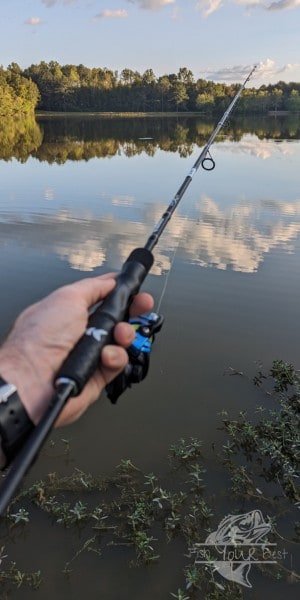
Fiberglass Rods
When evaluating materials for fishing rod construction, fiberglass rods stand out for their exceptional durability and flexibility, making them ideal for handling larger fish and enduring harsh fishing conditions. Their robustness and forgiving nature make them a top choice if you seek a long-lasting and reliable fishing rod.
Flexibility and Forgiveness:
- Allows for softer hook sets, beneficial for crappie with delicate mouths.
- Reduces the risk of hook pull-outs and line breaks.
Durability and Resilience:
- Offers robustness, advantageous in challenging fishing conditions.
- Withstands stresses and impacts associated with crappie fishing.
Weight and Sensitivity:
- Generally heavier compared to graphite rods.
- Offers adequate sensitivity for detecting crappie bites.
Versatility and User-Friendliness:
- Suitable for anglers of all experience levels.
- Adaptable to various fishing techniques and conditions.
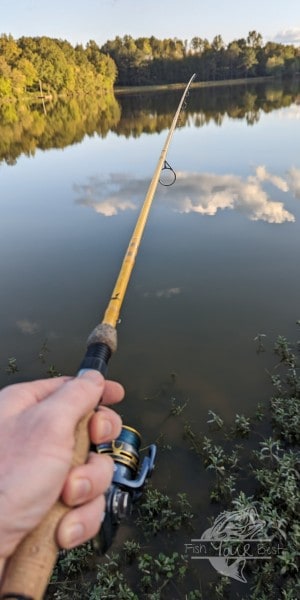
Composite Rods
When determining the optimal material for fishing rod construction, composite rods, which blend the properties of graphite and fiberglass, should be considered for their balanced performance and versatility. These rods offer a middle ground, providing the sensitivity and lightness of graphite while maintaining the strength and flexibility of fiberglass, making them suitable for a variety of fishing conditions and techniques.
Balanced Sensitivity and Strength:
- Allows detection of subtle bites and handling of the fight.
Durability and Flexibility:
- Ensures enhanced durability and flexibility.
- Reduces the risk of hook pull-outs and line breaks.
Versatility and Adaptability:
- Suitable for a range of crappie fishing techniques and conditions.
- A popular choice for multi-functional performance in diverse scenarios.
Weight and User-Friendliness:
- Slightly heavier than pure graphite rods but maintains a user-friendly profile.
- Offers a balanced fishing experience for varying skill levels and preferences.
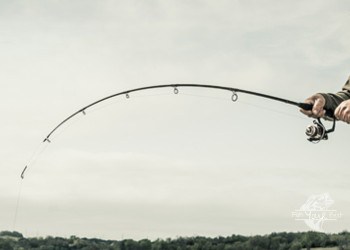
Graphite, fiberglass, or composite rods each offer unique benefits and characteristics that can enhance your crappie fishing experience. Selecting the right material for your needs and ensuring quality construction will contribute to a more fruitful and enjoyable pursuit of crappie.
Handle Type
The handle type of a fishing rod affects comfort, grip, and overall handling of the rod. Choosing the right handle type, tailored to the angler’s fishing style, targeted conditions, and personal preferences, significantly enhances the crappie fishing experience.
Material
The material of a fishing rod’s handle will determine your comfort, grip, and overall control during use. When selecting a fishing rod, it’s essential to consider handle materials like cork, EVA foam, or rubberized cork, as they can significantly influence your rod’s sensitivity, durability, and suitability for specific fishing environments and techniques.
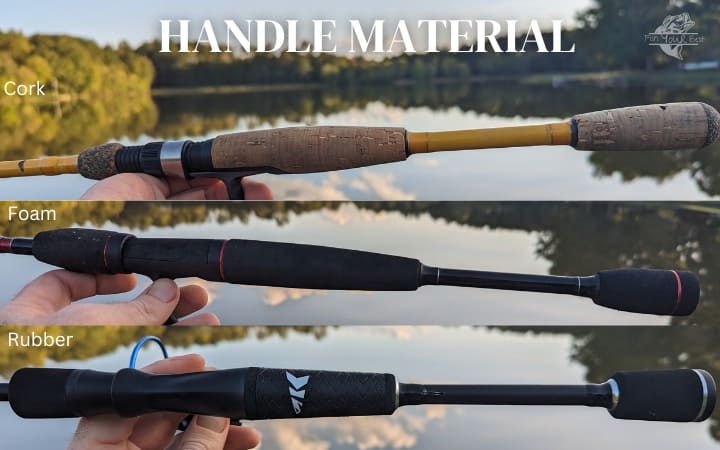
| Handle Material | Comfort | Sensitivity | Durability | Suitability for Crappie Fishing |
| Cork | High | High | Moderate | Excellent for sensitivity and comfort |
| EVA Foam | High | Moderate | High | Durable and comfortable; versatile in various conditions |
| Rubberized Cork | High | High | High | Balanced blend; suitable for comfort, sensitivity, and durability |
Length
The length of a fishing rod’s handle directly impacts your casting distance and leverage during battles with fish. When choosing a fishing rod, it’s crucial to consider handle length in relation to the intended fishing technique and target species, ensuring optimal balance, control, and comfort during extended fishing sessions.
Short Handles: Offer more control and are ideal for jigging and fishing in confined spaces.
Long Handles: Suitable for casting longer distances and offer more leverage.
Split Grip Handles: Reduce the overall weight of the rod and improve balance.
Full Grip Handles: Offer continuous support and are advantageous for more leverage when fighting fish.
Ergonomics
Ergonomically designed handles on fishing rods are key in ensuring comfort and reducing fatigue during prolonged fishing sessions. When selecting the ideal fishing rod, it’s worth prioritizing handle ergonomics to enhance grip, optimize hand placement, and ensure a more efficient and enjoyable angling experience.
Grip Texture
The grip texture on a fishing rod is crucial for ensuring a secure hold, especially in wet conditions, enhancing your control and precision. When evaluating the best fishing rod, consider grip texture to prevent slippage, reduce hand fatigue, and optimize overall fishing performance.
Smooth Grips: Provide a comfortable and natural feel but may become slippery when wet.
Textured Grips: Offer enhanced grip security, reducing the likelihood of the rod slipping even if wet.
Ribbed or Contoured Grips: Conforms to your hand, providing a more ergonomic hold and reducing hand fatigue.
Durability
When selecting a fishing rod, considering the durability of the grip is essential to ensure long-lasting performance and reliability, especially when frequently exposed to adverse conditions.
EVA Foam: Known for durability and resistance to wear and tear.
Cork: Offers excellent comfort and sensitivity but may be more prone to wear, tear, and damage.
Rubberized Cork: Combines the comfort of cork with the durability of rubber, offering a balanced and resilient option.
Sensitivity
When selecting a fishing rod, you should consider grip sensitivity, as it directly impacts your ability to detect bites and changes in lure movement, allowing you to time your hook set accurately.
| Handle Material | Sensitivity | Durability | Suitability for Crappie Fishing |
| Cork | High | Moderate | Excellent for high sensitivity and comfort |
| EVA Foam | Moderate | High | Suitable for varied conditions; durable and comfortable |
| Rubberized Cork | High | High | Balanced blend; versatile for sensitivity and durability |
Understanding the different aspects of handle types, from material to sensitivity, is essential for crappie anglers. It allows you to choose a suitable handle that aligns with your needs, preferences, and the specific fishing conditions.
Guides and Inserts: Enhancing Rod Performance
Guides and inserts are integral components of a fishing rod, ensuring smooth line movement, minimizing friction, and enhancing casting accuracy and distance. They are necessary for the precise presentation of lures and baits to crappie, contributing to the overall longevity and reliability of the rod, and optimizing the rod’s performance for a successful crappie catch.
Material
The choice of material for guides and inserts on a fishing rod directly impacts the rod’s durability, performance, and line friction, affecting your ability to cast and retrieve smoothly.
Stainless Steel Guides:
- Durability: Robust and resistant to corrosion.
- Suitability: Suitable for various environments, especially in saltwater conditions.
- Consideration: Heavier compared to other materials, affecting the overall balance and feel of the rod.
Ceramic Inserts:
- Performance: Known for their smooth surface, allowing for smoother and longer casts.
- Consideration: More brittle and can crack or break if impacted, requiring careful handling.
Titanium Guides:
- Durability: Lightweight and highly durable, resisting corrosion and maintaining shape under stress.
- Preference: Preferred for optimal performance and reduced rod weight.
Aluminum Oxide Inserts:
- Affordability: A common and cost-effective choice, balancing performance and affordability.
- Performance: Provides a smooth surface for the line to glide on.
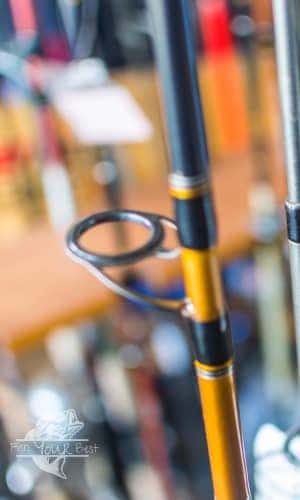
Strength in Numbers
The number of guides on your fishing rod plays a crucial role in distributing the load evenly across the rod, ensuring optimal performance and reducing the risk of rod breakage. A well-spaced arrangement of guides enhances casting accuracy and distance, providing greater control and precision during your fishing endeavors.
More Guides:
- Benefits: Allows for better line control and minimizes line slap against the rod blank, resulting in smoother and more accurate casts.
- Suitability: Beneficial for crappie anglers needing precise lure or bait placement.
Fewer Guides:
- Friction: Can lead to increased line friction and stress on the rod, affecting casting distance and accuracy.
- Impact: Reduced ability to reach desired fishing spots, decreasing chances of a successful catch.
Reel Seat: A Pivotal Component
The reel seat serves as the attachment point for the reel, ensuring stability, alignment, and a secure and firm hold on the reel. It is indispensable for optimizing rod and reel integration, enhancing performance, and ensuring a successful and pleasant crappie fishing experience.
Reel Seat Material
The reel seat material ensures a secure and stable connection between the rod and the reel, directly impacting the rod’s overall durability and performance. High-quality reel seat materials resist corrosion and wear, providing longevity and consistent performance, especially in challenging fishing environments.
Graphite Reel Seats:
- Benefits: Lightweight, corrosion-resistant, and popular for reduced rod weight and longevity.
- Consideration: May not offer the same level of strength as metal reel seats under high stress.
Aluminum Reel Seats:
- Benefits: Strong, durable, corrosion-resistant, suitable for both freshwater and saltwater.
- Consideration: Heavier compared to graphite reel seats.
Plastic Reel Seats:
- Benefits: Lighter and more affordable, suitable for cost-effective options.
- Consideration: Lacks the strength and durability of aluminum or graphite reel seats.
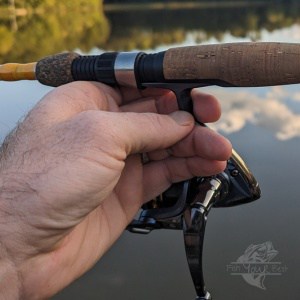
Composite Reel Seats:
- Benefits: Offers a balance between weight, strength, and durability.
- Consideration: A versatile option seeking a compromise between the lightweight nature of graphite and the strength of aluminum.
Reel Attachment Mechanism
The mechanism of the reel seat impacts how securely the reel is attached to the rod and how easily it can be adjusted or removed.
| Mechanism | Security | Ease of Adjustment | Suitability for Crappie Fishing |
| Screw-Down | High | High | Versatile; suitable for varied conditions and preferences |
| Clamp-On | Very High | Moderate | Robust; suitable for specific styles and larger fish |
| Sliding Ring | Moderate | High | Quick and easy; suitable for lightweight reels |
Reel Seat Location
The reel seat’s location influences the rod’s balance, handling, and overall performance.
Upper Location:
- Benefits: Provides a higher balance point, reducing fatigue during extended use; advantageous for using lighter lures and finesse techniques.
Middle Location:
- Benefits: Offers a balanced feel and is versatile for various crappie fishing techniques and conditions.
Lower Location:
- Benefits: Provides more leverage for casting and fighting fish, beneficial for using heavier lures or targeting larger crappie.
The reel seat is a critical fishing rod component, and selecting the appropriate one can impact your crappie fishing experience. The reel seat material, attachment mechanism, and placement should be chosen based on fishing conditions, reel type, and personal preferences. A good reel seat will guarantee a secure reel attachment and optimal rod performance, making it easier to use and more adaptable to different situations.
Portability: A Key Consideration
Portability is a key factor when selecting a fishing rod, as it determines the ease of transport and storage, especially if you frequently travel or have limited space. A highly portable rod offers the flexibility to fish in diverse locations and conditions, ensuring you are always prepared for any fishing adventure.
Length and Portability
Shorter Rods:
- Benefits: More portable, easier to manage, transport, and store, advantageous in areas with dense vegetation or overhanging branches.
Longer Rods:
- Benefits: Offers advantages in casting distance and line control, suitable for open waters or shore fishing.
- Consideration: More challenging to transport and maneuver.
Telescopic and Multi-Piece Rods:
- Benefits: Offers a solution to the portability challenges of longer rods, allowing them to be collapsed or broken down into smaller, more manageable pieces for transport.
Construction and Portability
One-Piece Rods:
- Benefits: Offer superior strength and sensitivity.
- Consideration: Cumbersome to transport due to their fixed length.
Multi-Piece Rods:
- Benefits: Highly portable and convenient for travel, allowing for compact storage and easy assembly.
Telescopic Rods:
- Benefits: Offer exceptional portability, condensing to a compact size that is ideal for backpacking or limited storage spaces.
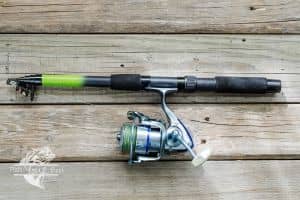
Material and Weight
Material: Lightweight materials like graphite make the rod easier to carry, reducing fatigue during transit.
Weight: Lightweight rods are inherently more portable, reducing strain during transport and allowing for more effortless handling and maneuvering.
Carrying Case
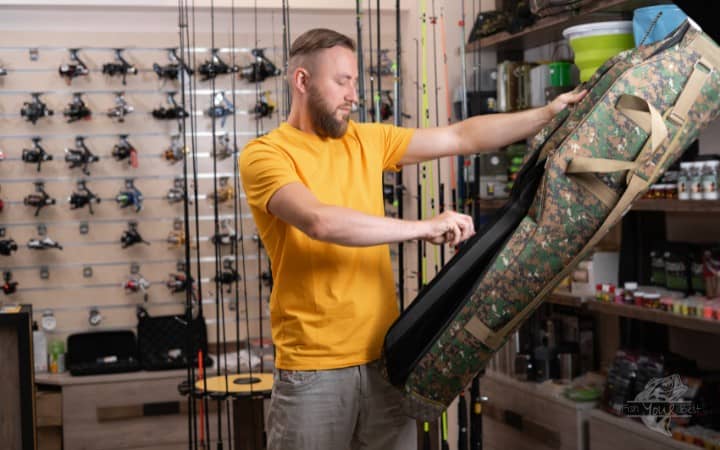
Protection: Offers protection to the rods from physical damage, environmental elements, and entanglement.
Organization: Allows for organized storage and transport of multiple rods, accessories, and tackle.
Ease of Transport: Makes transporting rods more manageable and comfortable, allowing for hands-free carrying.
Specialized Features: Some cases come with features like padded interiors, adjustable compartments, and lock mechanisms, catering to the specific needs and preferences of crappie anglers.
Portability is important for crappie fishing rods because it affects your ability to reach different fishing spots, increasing your odds of a catch. Portability can be improved by considering rod length, construction, material, weight, and carrying case. By balancing rod length’s advantages with portability’s convenience, you can effectively adapt to various crappie fishing conditions and preferences.
Cost Considerations
The cost of a fishing rod impacts the accessibility and quality of fishing equipment. It’s necessary to balance cost with quality, ensuring the chosen rod meets performance and durability expectations. The cost should align with your needs, preferences, and frequency of use.
Material Construction and Cost
Different materials offer varying levels of performance, durability, and price points.
Fiberglass Rods:
- Cost: Generally more affordable.
- Benefits: Durability and flexibility.
- Consideration: Heavier and less sensitive compared to graphite rods.
- Suitable For: Those who prioritize robustness and are on a budget.
Composite Rods:
- Cost: Balanced.
- Benefits: Offers a balance between sensitivity, strength, and cost.
- Suitable For: Those seeking the benefits of both graphite and fiberglass without extreme costs.
Graphite Rods:
- Cost: Typically more expensive.
- Benefits: High sensitivity, lightweight properties, and strength.
- Suitable For: Anglers seeking performance and precise bite detection.
Bamboo Rods:
- Cost: Often premium-priced.
- Benefits: Craftsmanship, aesthetic appeal, and unique, natural feel.
- Suitable For: Those who value tradition and the tactile experience.
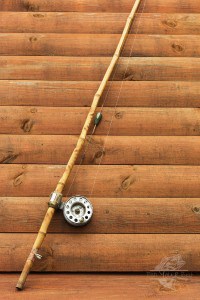
Brand Influence on Cost
Established Brands:
- Cost: Often command higher prices.
- Benefits: Reputation for quality, reliability, and innovation.
- Suitable For: Those seeking peace of mind and are willing to pay a premium for reliability.
Lesser-Known or New Brands:
- Cost: May offer lower prices to attract customers.
- Consideration: Essential to ensure that the lower cost does not compromise quality.
- Suitable For: Those on a tight budget but still seeking quality.
Length and Cost
Longer Rods:
- Cost: Usually come with a higher price tag.
- Benefits: Enhanced casting distance and line control.
- Suitable For: Those seeking an improved casting range and willing to allocate a higher budget.
Shorter Rods:
- Cost: Tend to be more affordable.
- Benefits: Portability and maneuverability in tight spaces.
- Suitable For: Those on a budget or with limited storage space.
When choosing a crappie fishing rod, consider the cost, material construction, brand, and length. A well-chosen rod that matches your budget, preferences, and fishing style makes a great addition to your fishing arsenal.
Brand Reputation & Customer Support
Brand reputation reflects crappie fishing rods’ quality, reliability, and performance. A reputable brand will likely produce durable and effective rods, backed by positive user reviews, advanced features, and technologies. Choosing a reputable brand provides confidence and assurance of quality and innovation to crappie anglers.
Product Warranty & Guarantee
- Product Warranty:
- Indication: Reflects a brand’s belief in the durability and quality of its products.
- Benefits: Provides a safety net against defects and performance issues, enhancing trust in the brand.
- Product Guarantee:
- Indication: Demonstrates a brand’s commitment to customer satisfaction.
- Benefits: Offers replacements or refunds, mitigating uncertainty and dissatisfaction from subpar products.
- Customer Service:
- Importance: Reinforces a positive brand image and shows the brand’s dedication to resolving issues.
- Benefits: Facilitates smooth resolution of concerns and inquiries, contributing to a pleasant post-purchase experience.
Customer Service & Support
- Responsiveness & Accessibility:
- Importance: Indicates reliability and a customer-centric approach.
- Benefits for Anglers: Provides quick solutions and information, reducing downtime and enhancing overall experience.
- Knowledge & Expertise:
- Importance: Indicates a brand’s proficiency and commitment to its products.
- Benefits for Anglers: Offers insights and guidance, optimizing the use of the fishing rods.
- Resolution & Satisfaction:
- Importance: Focus on effective resolution and customer satisfaction impacts brand perception positively.
- Benefits for Anglers: Smooth and satisfactory resolution process reinforces confidence in the brand.
- Post-Purchase Support:
- Importance: Enhances brand reputation by extending value beyond the point of sale.
- Benefits for Anglers: Ensures sustained product performance and user satisfaction.
The brand reputation of crappie fishing rods, underlined by warranties, guarantees, and exceptional customer service, should be a consideration before selecting a new fishing rod. These elements signify the brand’s commitment to quality and customer satisfaction and provide the necessary support and assurance, optimizing your fishing endeavors.
Maintenance and Care
Proper maintenance and care are a requirement when ensuring the longevity and performance of crappie fishing rods. The goal is to prevent corrosion, wear, and damage, providing reliable performance and maximizing the value of the investment made in the equipment.
Benefits for Anglers:
- Reliable performance
- Enhanced sensitivity
- Accurate casting
Key Consideration: Regular cleaning, proper storage, and timely repairs are the cornerstones of sustained fishing success and enjoyment.
Regular Cleaning
- Necessity: Removes dirt, salt, and grime, preventing corrosion and wear.
- Benefits for Anglers:
- Smooth line movement
- Accurate casting
- Reliable hook sets
- Special Consideration: Important when fishing in saltwater or muddy conditions to prevent the buildup of harmful residues.
Storage Conditions
- Environment:
- Store in a cool, dry place to prevent moisture accumulation and avoid exposure to extreme temperatures and direct sunlight.
- Physical Stress:
- Secure horizontal storage is optimal. Utilize rod racks or holders to protect the rod from falls, pressure, or entanglement.
- Rod Covers:
- Use rod covers or sleeves to protect the rod from dust, dirt, and scratches during transport.
- Reel Care:
- Remove the reel before storage, or use reel covers. Regular cleaning and lubrication of the reel are also essential.
Inspect for Damage
- Guides and Inserts:
- Regular inspection for wear, cracks, or misalignment is crucial. Replace any damaged components promptly.
- Rod Blank:
- Examine for any cracks, nicks, or fractures, especially around the guides and joints, and address any discovered damage immediately.
- Reel Seat:
- Inspect for any looseness, corrosion, or damage, and ensure the reel remains securely attached.
- Handle and Grips:
- Assess for wear, tear, or detachment to maintain comfort and grip during fishing.
A well-maintained rod means consistent performance, allowing you to focus more on fishing and less on equipment concerns.
Final Thoughts
I hope you’ve gained valuable insights and a deeper understanding of the many aspects of crappie fishing rods. From the intricacies of rod types, lengths, actions, and powers to the nuances of materials, construction, and maintenance, each element plays a pivotal role in optimizing your crappie fishing experience.
Crappie fishing is a nuanced and rewarding endeavor, and having the right rod tailored to your specific needs and preferences can significantly enhance your success and enjoyment on the water. Whether casting in shallow waters or trolling the depths, the knowledge acquired from this guide empowers you to make informed decisions, ensuring that your rod aligns with your fishing style, conditions, and the crappie’s behavior.
Remember, the pursuit of crappie is as much about the journey as it is about the catch. Continual learning, experimentation, and refinement of your techniques and equipment are the hallmarks of a dedicated crappie angler. Use this guide as a reference, revisit it whenever needed, and don’t hesitate to explore and try new approaches in your crappie fishing adventures.
Tight Lines and Happy Fishing!

